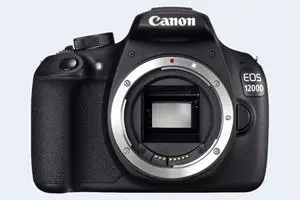Leica Q Typ 116 vs Canon 1200D
The Leica Q (Typ 116) and the Canon EOS 1200D (labelled Canon T5 in some countries) are two digital cameras that were officially introduced, respectively, in June 2015 and February 2014. The Q Typ 116 is a fixed lens compact, while the 1200D is a DSLR. The cameras are based on a full frame (Q Typ 116) and an APS-C (1200D) sensor. The Leica has a resolution of 24 megapixels, whereas the Canon provides 17.9 MP.
Below is an overview of the main specs of the two cameras as a starting point for the comparison.

Check Q Typ 116 offers at
ebay.com

Check 1200D offers at
ebay.com
Going beyond this snapshot of core features and characteristics, what are the differences between the Leica Q (Typ 116) and the Canon EOS 1200D? Which one should you buy? Read on to find out how these two cameras compare with respect to their body size, their imaging sensors, their shooting features, their input-output connections, and their reception by expert reviewers.
Body comparison
The physical size and weight of the Leica Q Typ 116 and the Canon 1200D are illustrated in the side-by-side display below. The two cameras are presented according to their relative size. Three consecutive views from the front, the top, and the rear side are shown. All size dimensions are rounded to the nearest millimeter.
The Q Typ 116 can be obtained in two different colors (black, silver), while the 1200D is only available in black.
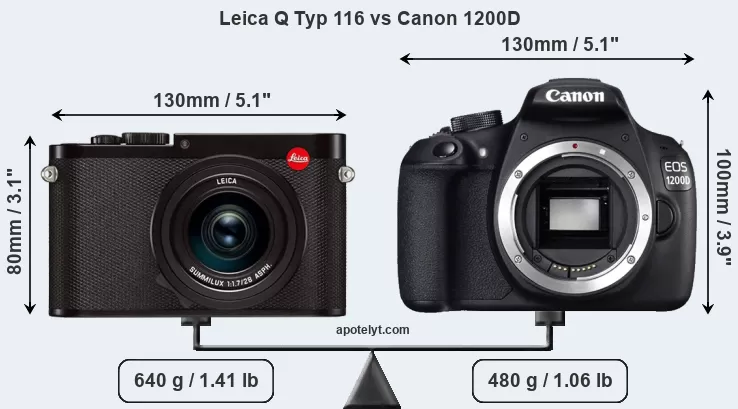
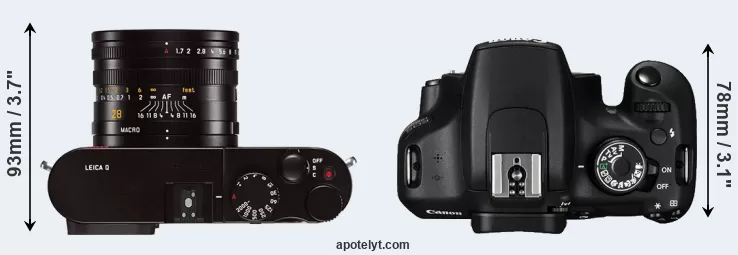
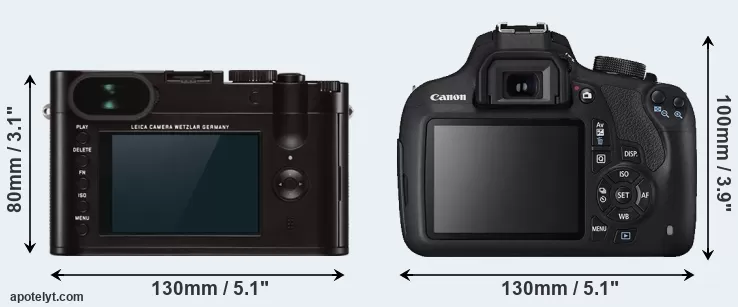
If the front view area (width x height) of the cameras is taken as an aggregate measure of their size, the Canon 1200D is notably larger (25 percent) than the Leica Q Typ 116. In this context, it is worth noting that neither the Q Typ 116 nor the 1200D are weather-sealed.
The above size and weight comparisons are to some extent incomplete and possibly misleading, as the Q Typ 116 has a lens built in, whereas the 1200D is an interchangeable lens camera that requires a separate lens. Attaching the latter will add extra weight and bulk to the setup. You can compare the optics available for the 1200D and their specifications in the Canon EF Lens Catalog.
Concerning battery life, the Q Typ 116 gets 300 shots out of its Leica BP-DC12 battery, while the 1200D can take 500 images on a single charge of its Canon LP-E10 power pack.
The table below summarizes the key physical specs of the two cameras alongside a broader set of comparators. If you want to switch the focus of the display and review another camera pair, you can move across to the CAM-parator tool and choose from the broad selection of possible camera comparisons there.

| Camera Model |
Camera Width |
Camera Height |
Camera Depth |
Camera Weight |
Battery Life |
Weather Sealing |
Camera Launch |
Launch Price (USD) |
Street Price |
||
|---|---|---|---|---|---|---|---|---|---|---|---|
| 1. | Leica Q Typ 116 | 130 mm | 80 mm | 93 mm | 640 g | 300 | n | Jun 2015 | 4,249 | ebay.com | |
| 2. | Canon 1200D | 130 mm | 100 mm | 78 mm | 480 g | 500 | n | Feb 2014 | 449 | ebay.com | |
| 3. | Canon 100D | 117 mm | 91 mm | 69 mm | 407 g | 380 | n | Mar 2013 | 549 | ebay.com | |
| 4. | Canon 700D | 133 mm | 100 mm | 79 mm | 580 g | 440 | n | Mar 2013 | 649 | ebay.com | |
| 5. | Canon 1100D | 130 mm | 100 mm | 78 mm | 495 g | 700 | n | Feb 2011 | 449 | ebay.com | |
| 6. | Canon 1300D | 129 mm | 101 mm | 78 mm | 485 g | 500 | n | Mar 2016 | 449 | ebay.com | |
| 7. | Canon 4000D | 129 mm | 102 mm | 77 mm | 436 g | 500 | n | Feb 2018 | 399 | amazon.com | |
| 8. | Canon G7 X | 103 mm | 60 mm | 40 mm | 304 g | 210 | n | Sep 2014 | 699 | ebay.com | |
| 9. | Canon T6i | 132 mm | 101 mm | 78 mm | 555 g | 440 | n | Feb 2015 | 749 | ebay.com | |
| 10. | Canon T6s | 132 mm | 101 mm | 78 mm | 565 g | 440 | n | Feb 2015 | 649 | ebay.com | |
| 11. | Kodak AZ901 | 139 mm | 104 mm | 119 mm | 777 g | 400 | n | Jan 2016 | 499 | amazon.com | |
| 12. | Leica M10 | 139 mm | 80 mm | 39 mm | 660 g | 210 | Y | Jan 2017 | 6,595 | ebay.com | |
| 13. | Leica Q2 | 130 mm | 80 mm | 92 mm | 718 g | 370 | Y | Mar 2019 | 4,995 | amazon.com | |
| 14. | Leica X Vario | 133 mm | 73 mm | 95 mm | 680 g | 450 | n | Jun 2013 | 2,850 | ebay.com | |
| 15. | Sony HX400V | 130 mm | 93 mm | 103 mm | 660 g | 300 | n | Feb 2014 | 499 | ebay.com | |
| 16. | Sony RX100 IV | 102 mm | 58 mm | 41 mm | 298 g | 280 | n | Jun 2015 | 999 | ebay.com | |
| 17. | Sony RX100 V | 102 mm | 58 mm | 41 mm | 299 g | 220 | n | Oct 2016 | 999 | ebay.com | |
| Note: Measurements and pricing do not include easily detachable parts, such as add-on or interchangeable lenses or optional viewfinders. | |||||||||||
The price is, of course, an important factor in any camera decision. The listed launch prices provide an indication of the market segment that the manufacturer of the cameras have been targeting. Usually, retail prices stay at first close to the launch price, but after several months, discounts become available. Later in the product cycle and, in particular, when the replacement model is about to appear, further discounting and stock clearance sales often push the camera price considerably down.
Sensor comparison
The size of the imaging sensor is a crucial determinant of image quality. All other things equal, a large sensor will have larger individual pixel-units that offer better low-light sensitivity, wider dynamic range, and richer color-depth than smaller pixels in a sensor of the same technological generation. Furthermore, a large sensor camera will give the photographer more possibilities to use shallow depth-of-field in order to isolate a subject from the background. On the downside, larger sensors are more costly to manufacture and tend to lead to bigger and heavier cameras and lenses.
Of the two cameras under consideration, the Leica Q Typ 116 features a full frame sensor and the Canon 1200D an APS-C sensor. The sensor area in the 1200D is 62 percent smaller. As a result of these sensor size differences, the cameras have a format factor of, respectively, 1.0 and 1.6. Both cameras have a native aspect ratio (sensor width to sensor height) of 3:2.
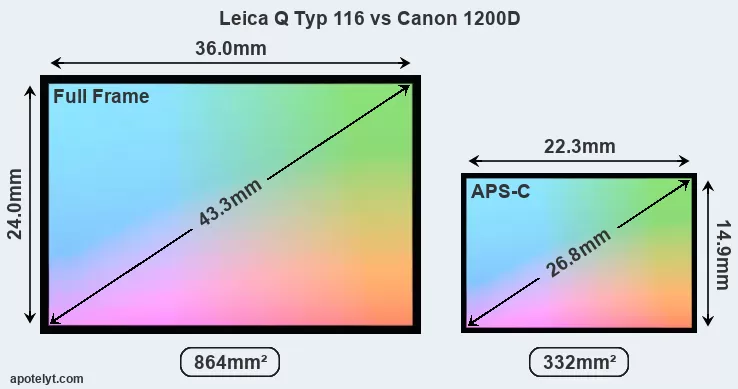
With 24MP, the Q Typ 116 offers a higher resolution than the 1200D (17.9MP), but the Q Typ 116 nevertheless has larger individual pixels (pixel pitch of 6.00μm versus 4.31μm for the 1200D) due to its larger sensor. Moreover, the Q Typ 116 is a somewhat more recent model (by 1 year and 3 months) than the 1200D, and its sensor might have benefitted from technological advances during this time that further enhance the light gathering capacity of its pixels.
The resolution advantage of the Leica Q Typ 116 implies greater flexibility for cropping images or the possibility to print larger pictures. The maximum print size of the Q Typ 116 for good quality output (200 dots per inch) amounts to 30 x 20 inches or 76.2 x 50.8 cm, for very good quality (250 dpi) 24 x 16 inches or 61 x 40.6 cm, and for excellent quality (300 dpi) 20 x 13.3 inches or 50.8 x 33.9 cm. The corresponding values for the Canon 1200D are 25.9 x 17.3 inches or 65.8 x 43.9 cm for good quality, 20.7 x 13.8 inches or 52.7 x 35.1 cm for very good quality, and 17.3 x 11.5 inches or 43.9 x 29.3 cm for excellent quality prints.
The Leica Q (Typ 116) has a native sensitivity range from ISO 100 to ISO 50000. The corresponding ISO settings for the Canon EOS 1200D are ISO 100 to ISO 6400, with the possibility to increase the ISO range to 100-12800.
Technology-wise, both cameras are equipped with CMOS (Complementary Metal–Oxide–Semiconductor) sensors. Both cameras use a Bayer filter for capturing RGB colors on a square grid of photosensors. This arrangement is found in most digital cameras.
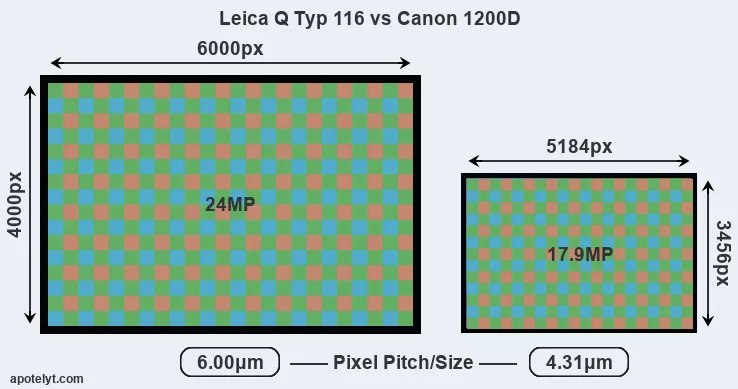
For many cameras, data on sensor performance has been reported by DXO Mark. This service is based on lab testing and assigns an overall score to each camera sensor, as well as ratings for dynamic range ("DXO Landscape"), color depth ("DXO Portrait"), and low-light sensitivity ("DXO Sports"). Of the two cameras under review, the Q Typ 116 provides substantially higher image quality than the 1200D, with an overall score that is 22 points higher. This advantage is based on 2.4 bits higher color depth, 1.4 EV in additional dynamic range, and 1.6 stops in additional low light sensitivity. The adjacent table reports on the physical sensor characteristics and the outcomes of the DXO sensor quality tests for a sample of comparator-cameras.

| Camera Model |
Sensor Class |
Resolution (MP) |
Horiz. Pixels |
Vert. Pixels |
Video Format |
DXO Portrait |
DXO Landscape |
DXO Sports |
DXO Overall |
||
|---|---|---|---|---|---|---|---|---|---|---|---|
| 1. | Leica Q Typ 116 | Full Frame | 24.0 | 6000 | 4000 | 1080/60p | 24.3 | 12.7 | 2221 | 85 | |
| 2. | Canon 1200D | APS-C | 17.9 | 5184 | 3456 | 1080/30p | 21.9 | 11.3 | 724 | 63 | |
| 3. | Canon 100D | APS-C | 17.9 | 5184 | 3456 | 1080/30p | 21.8 | 11.3 | 843 | 63 | |
| 4. | Canon 700D | APS-C | 17.9 | 5184 | 3456 | 1080/30p | 21.7 | 11.2 | 681 | 61 | |
| 5. | Canon 1100D | APS-C | 12.2 | 4272 | 2848 | 720/30p | 21.9 | 11.0 | 755 | 62 | |
| 6. | Canon 1300D | APS-C | 17.9 | 5184 | 3456 | 1080/30p | 22.0 | 11.7 | 781 | 66 | |
| 7. | Canon 4000D | APS-C | 17.9 | 5184 | 3456 | 1080/30p | 21.9 | 11.4 | 695 | 63 | |
| 8. | Canon G7 X | 1-inch | 20.0 | 5472 | 3648 | 1080/60p | 23.0 | 12.7 | 556 | 71 | |
| 9. | Canon T6i | APS-C | 24.0 | 6000 | 4000 | 1080/30p | 22.7 | 12.0 | 919 | 71 | |
| 10. | Canon T6s | APS-C | 24.0 | 6000 | 4000 | 1080/30p | 22.6 | 12.0 | 915 | 70 | |
| 11. | Kodak AZ901 | 1/2.3 | 20.2 | 5184 | 3888 | 1080/30p | 20.3 | 11.7 | 806 | 48 | |
| 12. | Leica M10 | Full Frame | 23.8 | 5952 | 3992 | none | 24.4 | 13.2 | 2133 | 86 | |
| 13. | Leica Q2 | Full Frame | 46.7 | 8368 | 5584 | 4K/30p | 26.4 | 13.5 | 2491 | 96 | |
| 14. | Leica X Vario | APS-C | 16.1 | 4928 | 3272 | 1080/30p | 23.4 | 12.7 | 1320 | 78 | |
| 15. | Sony HX400V | 1/2.3 | 20.2 | 5184 | 3888 | 1080/60p | 20.1 | 11.4 | 629 | 45 | |
| 16. | Sony RX100 IV | 1-inch | 20.0 | 5472 | 3648 | 4K/30p | 22.8 | 12.6 | 591 | 70 | |
| 17. | Sony RX100 V | 1-inch | 20.0 | 5472 | 3648 | 4K/30p | 22.8 | 12.4 | 586 | 70 | |
| Note: DXO values in italics represent estimates based on sensor size and age. | |||||||||||
Many modern cameras are not only capable of taking still images, but also of capturing video footage. Both cameras under consideration have a sensor with sufficiently fast read-out times for moving pictures, but the Q Typ 116 provides a higher frame rate than the 1200D. It can shoot video footage at 1080/60p, while the Canon is limited to 1080/30p.
Feature comparison
Apart from body and sensor, cameras can and do differ across a variety of features. For example, the Q Typ 116 has an electronic viewfinder (3680k dots), while the 1200D has an optical one. Both systems have their advantages, with the electronic viewfinder making it possible to project supplementary shooting information into the framing view, whereas the optical viewfinder offers lag-free viewing and a very clear framing image. The table below summarizes some of the other core capabilities of the Leica Q Typ 116 and Canon 1200D in connection with corresponding information for a sample of similar cameras.

| Camera Model |
Viewfinder (Type or 000 dots) |
Control Panel (yes/no) |
LCD Specifications (inch/000 dots) |
LCD Attach- ment |
Touch Screen (yes/no) |
Max Shutter Speed * |
Max Shutter Flaps * |
Built-in Flash (yes/no) |
Built-in Image Stab |
||
|---|---|---|---|---|---|---|---|---|---|---|---|
| 1. | Leica Q Typ 116 | 3680 | n | 3.0 / 1040 | fixed | Y | 1/2000s | 10.0/s | n | Y | |
| 2. | Canon 1200D | optical | n | 3.0 / 460 | fixed | n | 1/4000s | 3.0/s | Y | n | |
| 3. | Canon 100D | optical | n | 3.0 / 1040 | fixed | Y | 1/4000s | 4.9/s | Y | n | |
| 4. | Canon 700D | optical | n | 3.0 / 1040 | swivel | Y | 1/4000s | 5.0/s | Y | n | |
| 5. | Canon 1100D | optical | n | 2.7 / 230 | fixed | n | 1/4000s | 3.0/s | Y | n | |
| 6. | Canon 1300D | optical | n | 3.0 / 920 | fixed | n | 1/4000s | 3.0/s | Y | n | |
| 7. | Canon 4000D | optical | n | 2.7 / 230 | fixed | n | 1/4000s | 3.0/s | Y | n | |
| 8. | Canon G7 X | none | n | 3.0 / 1040 | tilting | Y | 1/2000s | 6.5/s | Y | Y | |
| 9. | Canon T6i | optical | n | 3.0 / 1040 | swivel | Y | 1/4000s | 5.0/s | Y | n | |
| 10. | Canon T6s | optical | Y | 3.0 / 1040 | swivel | Y | 1/4000s | 5.0/s | Y | n | |
| 11. | Kodak AZ901 | 202 | n | 3.0 / 920 | swivel | n | 1/2000s | 5.0/s | Y | Y | |
| 12. | Leica M10 | optical | n | 3.0 / 1037 | fixed | n | 1/4000s | 5.0/s | n | n | |
| 13. | Leica Q2 | 3680 | n | 3.0 / 1040 | fixed | Y | 1/2000s | 10.0/s | n | Y | |
| 14. | Leica X Vario | optional | n | 3.0 / 920 | fixed | n | 1/2000s | 5.0/s | Y | n | |
| 15. | Sony HX400V | 210 | n | 3.0 / 921 | tilting | n | 1/4000s | 10.0/s | Y | Y | |
| 16. | Sony RX100 IV | 2359 | n | 3.0 / 1228 | tilting | n | 1/2000s | 16.0/s | Y | Y | |
| 17. | Sony RX100 V | 2359 | n | 3.0 / 1229 | tilting | n | 1/2000s | 24.0/s | Y | Y | |
| Note: *) Information refers to the mechanical shutter, unless the camera only has an electronic one. | |||||||||||
One differentiating feature between the two cameras concerns the touch sensitivity of the rear screen. The Q Typ 116 has a touchscreen, while the 1200D has a conventional panel. Touch control can be particularly helpful, for example, for setting the focus point.
The reported shutter speed information refers to the use of the mechanical shutter. Yet, some cameras only have an electronic shutter, while others have an electronic shutter in addition to a mechanical one. In fact, the Q Typ 116 is one of those camera that have an additional electronic shutter, which makes completely silent shooting possible. However, this mode is less suitable for photographing moving objects (risk of rolling shutter) or shooting under artificial light sources (risk of flickering).
The Leica Q Typ 116 has an intervalometer built-in. This enables the photographer to capture time lapse sequences, such as flower blooming, a sunset or moon rise, without purchasing an external camera trigger and related software.
Concerning the storage of imaging data, both the Q Typ 116 and the 1200D write their files to SDXC cards. The Q Typ 116 supports UHS-I cards (Ultra High Speed data transfer of up to 104 MB/s), while the 1200D cannot take advantage of Ultra High Speed SD cards.
Connectivity comparison
For some imaging applications, the extent to which a camera can communicate with its environment can be an important aspect in the camera decision process. The table below provides an overview of the connectivity of the Leica Q (Typ 116) and Canon EOS 1200D and, in particular, the interfaces the cameras (and selected comparators) provide for accessory control and data transfer.

| Camera Model |
Hotshoe Port |
Internal Mic / Speaker |
Microphone Port |
Headphone Port |
HDMI Port |
USB Port |
WiFi Support |
NFC Support |
Bluetooth Support |
||
|---|---|---|---|---|---|---|---|---|---|---|---|
| 1. | Leica Q Typ 116 | Y | stereo / mono | - | - | micro | 2.0 | Y | Y | - | |
| 2. | Canon 1200D | Y | mono / mono | - | - | mini | 2.0 | - | - | - | |
| 3. | Canon 100D | Y | mono / mono | Y | - | mini | 2.0 | - | - | - | |
| 4. | Canon 700D | Y | stereo / mono | Y | - | mini | 2.0 | - | - | - | |
| 5. | Canon 1100D | Y | stereo / mono | - | - | mini | 2.0 | - | - | - | |
| 6. | Canon 1300D | Y | mono / mono | - | - | mini | 2.0 | Y | Y | - | |
| 7. | Canon 4000D | Y | mono / mono | - | - | mini | 2.0 | Y | Y | - | |
| 8. | Canon G7 X | - | stereo / mono | - | - | micro | 2.0 | Y | Y | - | |
| 9. | Canon T6i | Y | stereo / mono | Y | - | mini | 2.0 | Y | Y | - | |
| 10. | Canon T6s | Y | stereo / mono | Y | - | mini | 2.0 | Y | Y | - | |
| 11. | Kodak AZ901 | - | stereo / mono | - | - | micro | 2.0 | Y | - | - | |
| 12. | Leica M10 | Y | - / - | - | - | - | - | Y | - | - | |
| 13. | Leica Q2 | Y | stereo / mono | - | - | - | - | Y | - | Y | |
| 14. | Leica X Vario | Y | stereo / mono | - | - | mini | 2.0 | - | - | - | |
| 15. | Sony HX400V | Y | stereo / mono | - | - | micro | 2.0 | Y | Y | - | |
| 16. | Sony RX100 IV | - | stereo / mono | - | - | micro | 2.0 | Y | Y | - | |
| 17. | Sony RX100 V | - | stereo / mono | - | - | micro | 2.0 | Y | Y | - |
It is notable that the Q Typ 116 offers wifi support, while the 1200D does not. Wifi can be a very convenient means to transfer image data to an off-camera location.
Both the Q Typ 116 and the 1200D have been discontinued, but can regularly be found used on ebay. The 1200D was replaced by the Canon 1300D, while the Q Typ 116 was followed by the Leica Q2. Further information on the features and operation of the Q Typ 116 and 1200D can be found, respectively, in the Leica Q Typ 116 Manual (free pdf) or the online Canon 1200D Manual.
Review summary
So how do things add up? Is the Leica Q Typ 116 better than the Canon 1200D or vice versa? A synthesis of the relative strong points of each of the models is listed below.

Reasons to prefer the Leica Q (Typ 116):
- More detail: Offers more megapixels (24 vs 17.9MP) with a 16% higher linear resolution.
- Better image quality: Scores substantially higher (22 points) in the DXO overall assessment.
- Richer colors: Generates images with noticeably better colors (2.4 bits more color depth).
- More dynamic range: Captures a larger spectrum of light and dark details (1.4 EV of extra DR).
- Better low-light sensitivity: Requires less light for good images (1.6 stops ISO advantage).
- Better video: Provides higher movie framerates (1080/60p versus 1080/30p).
- More framing info: Has an electronic viewfinder that displays shooting data.
- More detailed LCD: Has a higher resolution rear screen (1040k vs 460k dots).
- Fewer buttons to press: Is equipped with a touch-sensitive rear screen to facilitate handling.
- Faster burst: Shoots at higher frequency (10 vs 3 flaps/sec) to capture the decisive moment.
- Less disturbing: Has an electronic shutter option for completely silent shooting.
- Easier time-lapse photography: Has an intervalometer built-in for low frequency shooting.
- Ready to shoot: Comes with a built-in lens, while the 1200D requires a separate lens.
- More compact: Is smaller (130x80mm vs 130x100mm) and thus needs less room in the bag.
- Sharper images: Has hand-shake reducing image stabilization built-in.
- Easier file upload: Has wifi built in for automatic backup or image transfer to the web.
- Easier device pairing: Supports NFC for fast wireless image transfer over short distances.
- Faster buffer clearing: Has an SD card interface that supports the UHS-I standard.
- More prestigious: Has the Leica luxury appeal, which ensures a high resale price.
- More modern: Is somewhat more recent (announced 1 year and 3 months after the 1200D).

Arguments in favor of the Canon EOS 1200D:
- Brighter framing: Features an optical viewfinder for clear, lag-free composition.
- Faster shutter: Has higher mechanical shutter speed (1/4000s vs 1/2000s) to freeze action.
- More flexible: Makes it possible to change lenses and thus to use specialty optics.
- Longer lasting: Gets more shots (500 versus 300) out of a single battery charge.
- Easier fill-in: Has a small integrated flash to brighten shadows of backlit subjects.
- More heavily discounted: Has been on the market for longer (launched in February 2014).
If the number of relative strengths (bullet points above) is taken as a guide, the Q Typ 116 is the clear winner of the match-up (20 : 6 points). However, the relative importance of the various individual camera aspects will vary according to personal preferences and needs, so that you might like to apply corresponding weights to the particular features before making a decision on a new camera. A professional wedding photographer will view the differences between cameras in a way that diverges from the perspective of a travel photog, and a person interested in cityscapes has distinct needs from a macro shooter. Hence, the decision which camera is best and worth buying is often a very personal one.
How about other alternatives? Do the specifications of the Leica Q Typ 116 and the Canon 1200D place the cameras among the top in their class? Find out in the latest Best Prime Lens Compact Camera and Best DSLR Camera listings whether the two cameras rank among the cream of the crop.
In any case, while the comparison of the spec-sheets of cameras can offer a general idea of their imaging potential, it remains partial and cannot reveal, for example, the shooting experience and imaging performance when actually working with the Q Typ 116 or the 1200D. User reviews that are available, for instance, at amazon can sometimes shed light on these issues, but such feedback is all too often partial, inconsistent, and inaccurate.
Expert reviews
This is why expert reviews are important. The following table reports the overall ratings of the cameras as published by some of the major camera review sites (amateurphotographer [AP], cameralabs [CL], digitalcameraworld [DCW], dpreview [DPR], ephotozine [EPZ], photographyblog [PB]). As can be seen, the professional reviewers agree in many cases on the quality of different cameras, but sometimes their assessments diverge, reinforcing the earlier point that a camera decision is often a very personal choice.

| Camera Model |
AP score |
CL score |
DCW score |
DPR score |
EPZ score |
PB score |
Camera Launch |
Launch Price (USD) |
Street Price |
||
|---|---|---|---|---|---|---|---|---|---|---|---|
| 1. | Leica Q Typ 116 | 5/5 | .. | .. | 80/100 | 4.5/5 | 4.5/5 | Jun 2015 | 4,249 | ebay.com | |
| 2. | Canon 1200D | 3/5 | + | .. | .. | 4/5 | 4.5/5 | Feb 2014 | 449 | ebay.com | |
| 3. | Canon 100D | 4/5 | + | .. | 78/100 | 4/5 | 4/5 | Mar 2013 | 549 | ebay.com | |
| 4. | Canon 700D | .. | .. | .. | 76/100 | 4.5/5 | 4.5/5 | Mar 2013 | 649 | ebay.com | |
| 5. | Canon 1100D | .. | 80/100 | .. | 69/100 | 4/5 | 4.5/5 | Feb 2011 | 449 | ebay.com | |
| 6. | Canon 1300D | 4/5 | o | 4/5 | 73/100 | 4/5 | 4/5 | Mar 2016 | 449 | ebay.com | |
| 7. | Canon 4000D | 2.5/5 | o | 3/5 | .. | 3.5/5 | 3.5/5 | Feb 2018 | 399 | amazon.com | |
| 8. | Canon G7 X | 4/5 | + + | .. | 77/100 | 4.5/5 | 4.5/5 | Sep 2014 | 699 | ebay.com | |
| 9. | Canon T6i | 5/5 | .. | .. | 75/100 | 4.5/5 | 4.5/5 | Feb 2015 | 749 | ebay.com | |
| 10. | Canon T6s | 5/5 | + | .. | 77/100 | 4.5/5 | 4.5/5 | Feb 2015 | 649 | ebay.com | |
| 11. | Kodak AZ901 | .. | .. | .. | .. | 3.5/5 | 3/5 | Jan 2016 | 499 | amazon.com | |
| 12. | Leica M10 | 4.5/5 | .. | .. | .. | 4/5 | 4.5/5 | Jan 2017 | 6,595 | ebay.com | |
| 13. | Leica Q2 | .. | .. | 4.5/5 | 84/100 | 4.5/5 | 4/5 | Mar 2019 | 4,995 | amazon.com | |
| 14. | Leica X Vario | 3/5 | .. | .. | .. | 4/5 | 4/5 | Jun 2013 | 2,850 | ebay.com | |
| 15. | Sony HX400V | 4/5 | + + | .. | .. | 4/5 | 4/5 | Feb 2014 | 499 | ebay.com | |
| 16. | Sony RX100 IV | 4.5/5 | + + | .. | 85/100 | 4/5 | 4.5/5 | Jun 2015 | 999 | ebay.com | |
| 17. | Sony RX100 V | 4.5/5 | + + | .. | 83/100 | 4/5 | 4.5/5 | Oct 2016 | 999 | ebay.com | |
| Note: (+ +) highly recommended; (+) recommended; (o) reviewed; (..) not available. | |||||||||||
Care should be taken when interpreting the review scores above, though. The ratings are only valid when referring to cameras in the same category and of the same age. Thus, a score needs to be put into the context of the launch date and the launch price of the camera, and comparing ratings of very distinct cameras or ones that are far apart in terms of their release date have little meaning. It should also be noted that some of the review sites have over time altered the way they render their verdicts.

Check Q Typ 116 offers at
ebay.com

Check 1200D offers at
ebay.com
Other camera comparisons
Did this review help to inform your camera decision process? In case you would like to check on the differences and similarities of other camera models, just use the search menu below. As an alternative, you can also directly jump to any one of the listed comparisons that were previously generated by the CAM-parator tool.
- Canon 1200D vs Canon G1 X
- Canon 1200D vs Fujifilm X-A1
- Canon 1200D vs Nikon D90
- Canon 1200D vs Nikon P1000
- Canon 1200D vs Panasonic TZ100
- Canon 1200D vs Sony RX10
- Canon 6D vs Leica Q Typ 116
- Canon R6 Mark II vs Leica Q Typ 116
- Fujifilm X-T3 vs Leica Q Typ 116
- Leica M-E Typ 240 vs Leica Q Typ 116
- Leica Q Typ 116 vs Nikon Df
- Leica Q Typ 116 vs Olympus E-PL2
Specifications: Leica Q Typ 116 vs Canon 1200D
Below is a side-by-side comparison of the specs of the two cameras to facilitate a quick review of their differences and common features.
| Camera Model | Leica Q Typ 116 | Canon 1200D |
|---|---|---|
| Camera Type | Fixed lens compact camera | Digital single lens reflex |
| Camera Lens | 28mm f/1.7 | Canon EF mount lenses |
| Launch Date | June 2015 | February 2014 |
| Launch Price | USD 4,249 | USD 449 |
| Sensor Specs | Leica Q Typ 116 | Canon 1200D |
| Sensor Technology | CMOS | CMOS |
| Sensor Format | Full Frame Sensor | APS-C Sensor |
| Sensor Size | 36.0 x 24.0 mm | 22.3 x 14.9 mm |
| Sensor Area | 864 mm2 | 332.27 mm2 |
| Sensor Diagonal | 43.3 mm | 26.8 mm |
| Crop Factor | 1.0x | 1.6x |
| Sensor Resolution | 24 Megapixels | 17.9 Megapixels |
| Image Resolution | 6000 x 4000 pixels | 5184 x 3456 pixels |
| Pixel Pitch | 6.00 μm | 4.31 μm |
| Pixel Density | 2.78 MP/cm2 | 5.39 MP/cm2 |
| Moiré control | Anti-Alias filter | Anti-Alias filter |
| Movie Capability | 1080/60p Video | 1080/30p Video |
| ISO Setting | 100 - 50,000 ISO | 100 - 6,400 ISO |
| ISO Boost | no Enhancement | 100 - 12,800 ISO |
| Image Processor | Maestro II | DIGIC 4 |
| DXO Sensor Quality (score) | 85 | 63 |
| DXO Color Depth (bits) | 24.3 | 21.9 |
| DXO Dynamic Range (EV) | 12.7 | 11.3 |
| DXO Low Light (ISO) | 2221 | 724 |
| Screen Specs | Leica Q Typ 116 | Canon 1200D |
| Viewfinder Type | Electronic viewfinder | Optical viewfinder |
| Viewfinder Field of View | 100% | 95% |
| Viewfinder Magnification | 0.50x | |
| Viewfinder Resolution | 3680k dots | |
| LCD Framing | Live View | Live View |
| Rear LCD Size | 3.0inch | 3.0inch |
| LCD Resolution | 1040k dots | 460k dots |
| LCD Attachment | Fixed screen | Fixed screen |
| Touch Input | Touchscreen | no Touchscreen |
| Shooting Specs | Leica Q Typ 116 | Canon 1200D |
| Focus System | Contrast-detect AF | Phase-detect AF |
| Manual Focusing Aid | Focus Peaking | no Peaking Feature |
| Continuous Shooting | 10 shutter flaps/s | 3 shutter flaps/s |
| Electronic Shutter | up to 1/16000s | no E-Shutter |
| Time-Lapse Photography | Intervalometer built-in | no Intervalometer |
| Fill Flash | no On-Board Flash | Built-in Flash |
| Storage Medium | SDXC cards | SDXC cards |
| Single or Dual Card Slots | Single card slot | Single card slot |
| UHS card support | UHS-I | no |
| Connectivity Specs | Leica Q Typ 116 | Canon 1200D |
| External Flash | Hotshoe | Hotshoe |
| USB Connector | USB 2.0 | USB 2.0 |
| HDMI Port | micro HDMI | mini HDMI |
| Wifi Support | Wifi built-in | no Wifi |
| Near-Field Communication | NFC built-in | no NFC |
| Body Specs | Leica Q Typ 116 | Canon 1200D |
| Battery Type | Leica BP-DC12 | Canon LP-E10 |
| Battery Life (CIPA) | 300 shots per charge | 500 shots per charge |
| Body Dimensions |
130 x 80 x 93 mm (5.1 x 3.1 x 3.7 in) |
130 x 100 x 78 mm (5.1 x 3.9 x 3.1 in) |
| Camera Weight | 640 g (22.6 oz) | 480 g (16.9 oz) |

Check Q Typ 116 offers at
ebay.com

Check 1200D offers at
ebay.com
Did you notice an error on this page? If so, please get in touch, so that we can correct the information.

